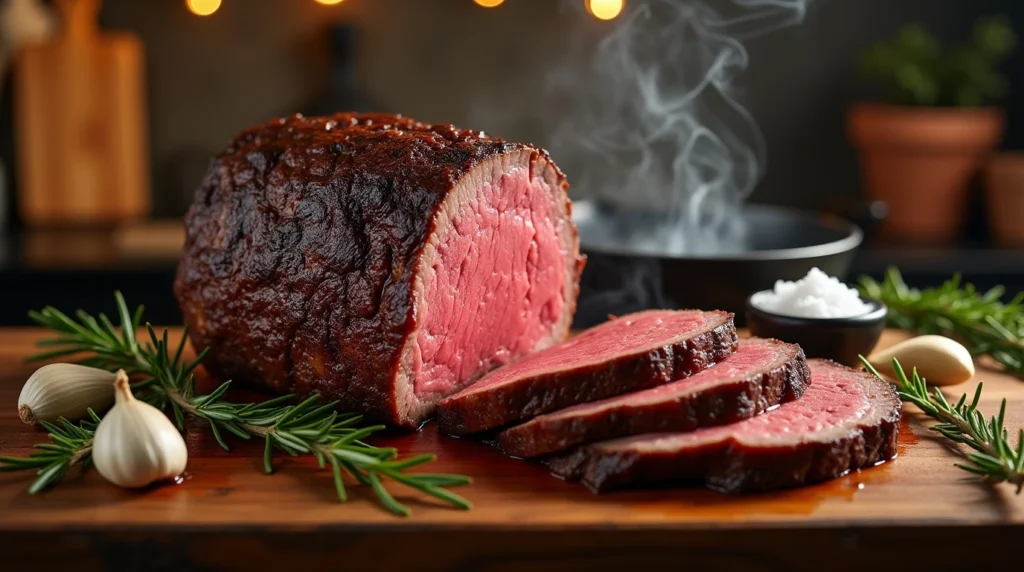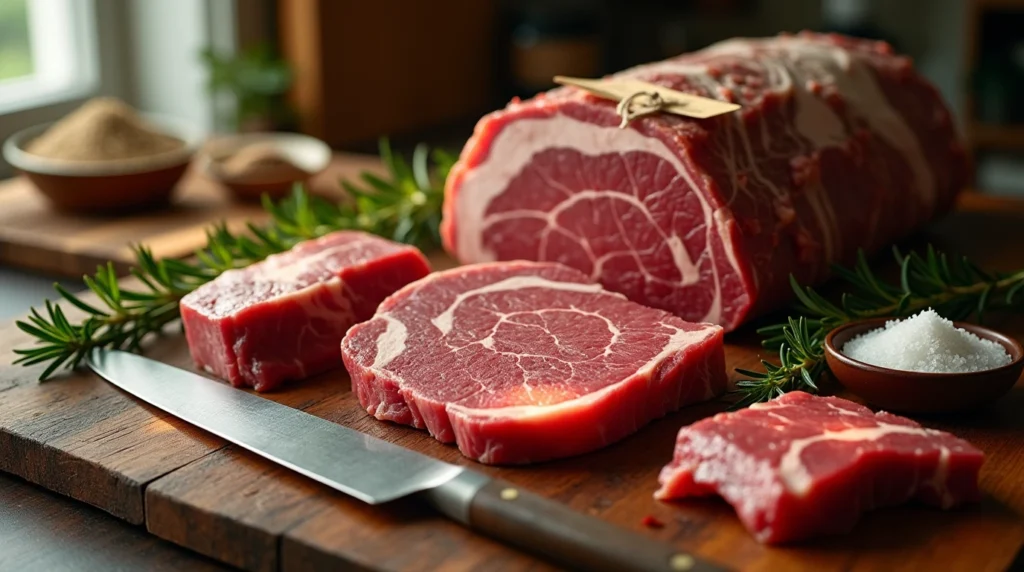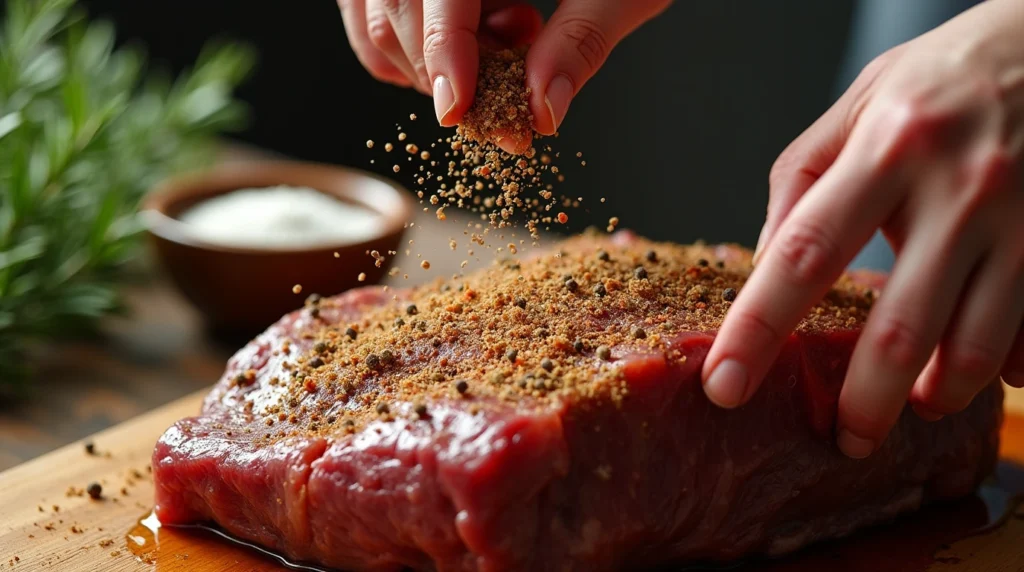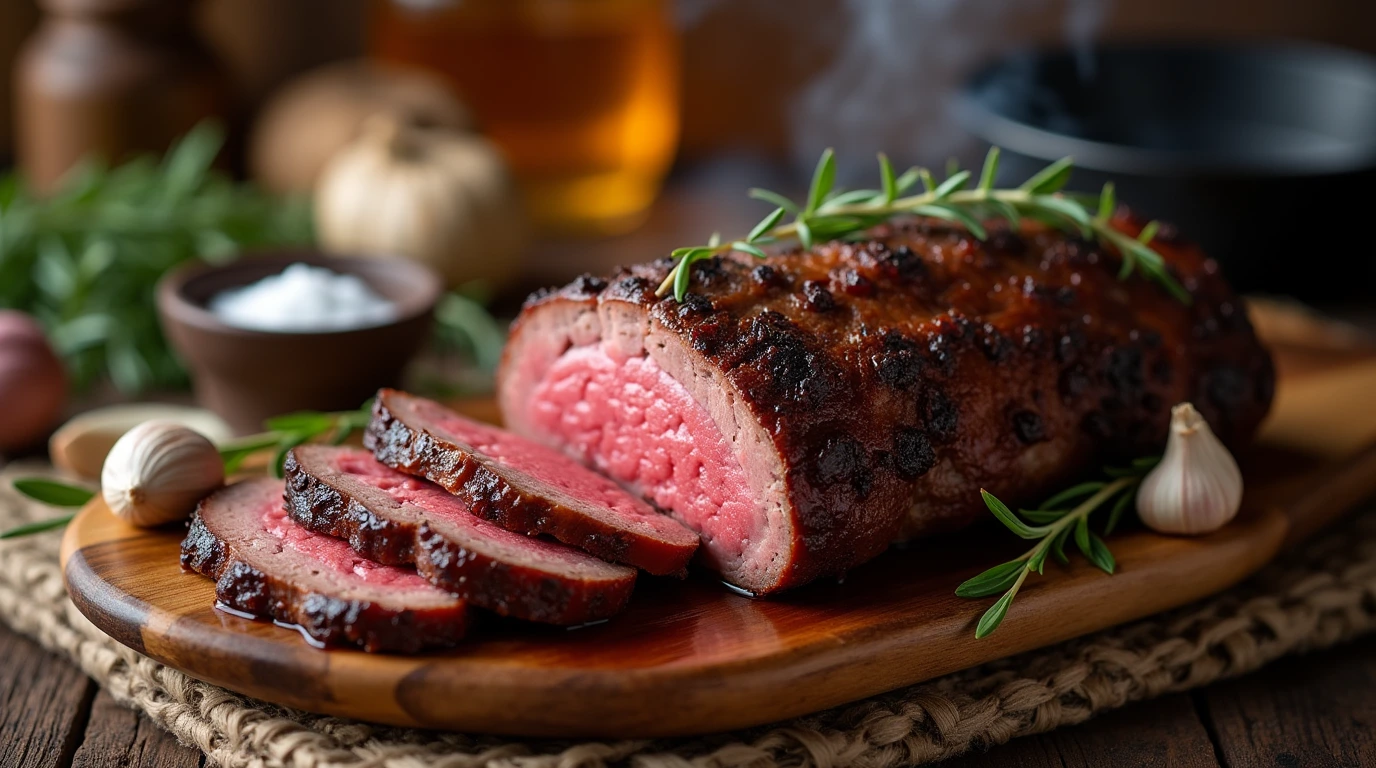Mastering a smoked beef roast is more than just grilling meat. It requires the right techniques for a juicy smoked roast. This guide will share expert tips for tenderness to make your roast both flavorful and succulent.
We’ll cover everything from choosing the right cut to perfecting your smoking method. You’ll learn valuable insights to improve your barbecue beef recipes. Impress your family and friends with the perfect smoked roast that keeps them coming back for more!

Key Takeaways
- Choose a chuck roast between 6-8 lbs for optimal results.
- Wet-aging the roast can significantly enhance tenderness.
- Target a smoking temperature of 275°F to 315°F for better outcomes.
- Rest the meat for an hour post-cooking for maximum juiciness.
- Use wood types like oak, hickory, or pecan to boost flavor.
- Store leftovers in a sealed container for freshness.
Understanding the Basics of Smoking Meat
Smoking meat involves heat, smoke, and moisture. This mix not only cooks the meat but also adds deep flavors. Different smoking methods can change the taste and texture of the meat.
There are two main ways to smoke meat: direct and indirect. Direct smoking means the meat is near the flames. Indirect smoking cooks the meat away from the heat.
The type of meat cut is key. Cuts like chuck roast need slow cooking to break down tough tissues. They cook best at 200 to 220 degrees Fahrenheit. For safety, the meat should reach 145 degrees Fahrenheit.
Choosing the right fuel is important. Fuels like charcoal, wood pellets, propane, and electricity can change the flavor. Hardwood is best for a strong smoky taste. Smoking times vary, from 1 hour to over 20 hours.
The 3-2-1 rule is a popular method. It involves smoking for three hours, then wrapping in foil for two hours, and finishing uncovered for one hour. This helps improve the meat’s texture.
| Smoker Type | Price Range | Fuel Type | Flavor Profile |
|---|---|---|---|
| Drum Smoker | $150 – $500 | Charcoal | Deep and rich |
| Electric Smoker | $200 – $2,000 | Electricity | Soft and mild |
| Pellet Smoker | $300 – $3,000 | Wood Pellets | Varied, depending on wood |
| High-End Smoker | $5,000 – $20,000 | Multiple options | Complex and nuanced |
Learning these basics helps anyone smoke meat well. Knowing about cuts, methods, and heat control is key. It leads to making delicious smoked beef roast that will impress everyone.
Choosing the Right Cut for Smoked Beef Roast
Choosing the right cut of beef is key to a memorable smoked roast. The best cuts for smoked beef greatly affect the flavor and tenderness. Among these, chuck roast and round roast for smoking are top choices.
The chuck roast is known for its marbling, which adds rich flavor and keeps it moist. It takes about 5 to 6 hours to smoke, allowing the flavors to blend well. On the other hand, the round roast is leaner but still produces great results. It only needs 4 to 5 hours to smoke and might not be as juicy as chuck roast.
Understanding marbling is crucial when picking a cut. More intramuscular fat means better flavor and moisture retention. For the best taste and texture, choose marbled cuts like chuck roast.
The table below summarizes key attributes of the chosen cuts:
| Cut | Marbling | Flavor | Cook Time | Internal Temp Target |
|---|---|---|---|---|
| Chuck Roast | High | Rich and Savory | 5-6 hours | 205°F |
| Round Roast | Low | Mild | 4-5 hours | 135°F |

Choosing between chuck roast and round roast for smoking depends on your preference. Each cut has its own benefits, making it important to know how they’ll change your smoked beef experience.
Preparing Your Smoker for Optimal Results
Getting your smoker ready is key to tender, juicy beef roasts. First, set up your smoker right to reach the best smoking conditions. The smoker type you choose affects your cooking. Electric, charcoal, and pellet smokers each have their own benefits and challenges.
Electric smokers are easy to use and keep the heat steady. Charcoal smokers give rich flavors but need more work. Pellet smokers are versatile and easy to use, making great results.
Before you start, heat your smoker to 225-250°F. This is important for even cooking. Next, get your smoking wood ready. Hickory, mesquite, oak, and cherry wood chips add unique flavors.
Keep your smoker well-ventilated for even heat. Good airflow helps prevent overheating and keeps the roast balanced.
Timing is crucial in preparing your smoker. A 3-4 pound roast cooks in 3-5 hours. A 4-6 pound roast takes 5 hours or more. Aim for 4-6 hours for the best taste.
Check the internal temperature to ensure the roast is cooked right. Aim for 130°F for medium-rare. Wrap the roast at 160 degrees to keep it moist and tender.
How to Properly Season Your Smoked Beef Roast
Seasoning your smoked beef is key to making it taste amazing. A good mix of spices not only boosts the flavor but also makes your kitchen smell great. Popular rubs include kosher salt, black pepper, garlic, and rosemary. These ingredients help the beef soak up all the flavors.
Think about marinating your beef before you start smoking. A tasty marinade makes the meat tender and juicy. After rubbing the meat, let it sit for a while. This lets the spices really get into the meat.
Letting it rest for at least six hours, or even overnight, makes it taste better. This way, the meat absorbs all the flavors.
Using Jeff’s Original or Jeff’s Texas style rub can make your beef even more delicious. These rubs are made for smoked meats and will make your dish stand out. Remember, seasoning is a crucial step that can turn your beef into something truly special.
Seasoning your beef right brings out its natural taste and adds to the smoky aroma. Learning how to season your smoked beef will impress everyone and boost your cooking skills.

Smoked Beef Roast: Timing and Temperature Guidelines
Getting the right cooking temperatures and smoking times is key to a perfect smoked beef roast. It’s important to check the internal temperature to ensure it’s cooked just right. This helps keep the meat juicy and prevents it from being too raw or overcooked.
Understanding Internal Temperatures
The internal temperature of smoked beef is crucial for both taste and safety. For a medium-rare roast, aim for 130°F to 135°F. If you prefer it medium, go for 135°F to 145°F. Here’s a guide to help you manage these temperatures:
| Beef Cut | Internal Temp (°F) | Cooking Time | Smoker Temp (°F) |
|---|---|---|---|
| Brisket (packer) | 205°F (well-done) | 12-18 hours | 225°-250°F |
| Beef Tenderloin | 120°F-125°F (rare); 130°F-135°F (medium-rare) | 45-60 min smoking + 6-10 min grilling | 225°-250°F |
| Strip Steak | 120°F-125°F (rare); 130°F-135°F (medium-rare) | 45-60 min smoking + 4-6 min grilling | 225°-250°F |
| Tri-Tip | 120°F-125°F (rare); 130°F-135°F (medium-rare) | 1 hour smoking + 4-6 min grilling | 225°-250°F |
| Beef Jerky | Browned and dried, but still flexible | 3½-4 hours | 160°F |
Recommended Cook Times for Different Roast Weights
Knowing the right cooking times for different roast sizes is important. For example, a 3-4 pound chuck roast takes about 7-8 hours to cook. Here’s a guide for cooking times based on roast weight:
| Weight (lbs) | Cooking Time (hours) |
|---|---|
| 3-4 | 7-8 |
| 4-6 | 8-10 |
| 6-8 | 10-12 |
| 8-10 | 12-14 |
| 10-12 | 14-16 |
Techniques to Ensure Tenderness and Juiciness
To make smoked beef tender and juicy, you need to follow some key steps. First, let the meat rest after cooking. Second, use a digital meat thermometer to check the temperature. These steps help make your smoked beef roast delicious and moist.
The Importance of Resting the Meat
Resting smoked beef is a step many miss. After smoking, let the chuck roast rest in a dry cooler for about an hour. This lets the juices spread evenly, making each bite juicy and full of flavor.
If you skip this step, the juices will leak out when you slice it. This makes the meat dry. So, resting the meat is crucial for a juicy dish.
Using a Digital Meat Thermometer
A good meat thermometer is essential for smoking beef. For chuck roasts, aim for an internal temperature of about 195°F for the best tenderness. Keeping an eye on the temperature prevents overcooking or undercooking.
This is key because smoking a 3-4 pound chuck roast takes 6 to 7 hours. With the right temperature, your smoked beef roast will impress everyone at your gathering.
Adding Flavor: Wood Types and Smoking Materials
Choosing the right wood is key to flavoring meat. Different woods give unique tastes to your smoked beef. Knowing about wood profiles can make your cooking better and your beef roast more enjoyable.
Best Wood Choices for Smoking Beef
Hickory and oak are top choices for smoking beef. They give a deep color and strong flavors that match well with heavy meats. Here’s a look at popular woods for smoking beef:
| Wood Type | Flavor Profile | Best Uses |
|---|---|---|
| Hickory | Strong, savory | Ribs, pork shoulders, red meat |
| Oak | Medium, smoky | Brisket, lamb, sausages |
| Pecan | Rich, sweet, nutty | Briskets, roasts, ribs |
| Mesquite | Intense, earthy | Red meat, grilling |
Fruit woods like cherry and apple offer a milder smoke. They’re good for lighter meats. Alder is best for fish like salmon. Trying different woods can lead to new flavors.
Experimenting with Smoking Chips and Chunks
Think about the wood type and how you use it. Smoking chips give a quick flavor boost. Chunks burn longer and are great for longer smokes. Don’t smoke for more than half the time to avoid too much flavor.
Mixing hickory with cherry can create amazing tastes. It’s all about finding your favorite flavors.
Trying out different woods can help you find your favorite flavors. Wood choice is crucial for a great smoked beef roast.
Creative Serving Ideas and Side Dishes
Turning your smoked beef into a special meal is all about the right pairings. Whether it’s the main dish or a part of a casual meal, the right sides and sauces make a big difference. Here are some classic and new ideas to try.
Pairing Sauces and Condiments
For sauces, horseradish cream sauce adds a spicy kick that enhances the beef’s flavor. If you like a bit of sweetness, barbecue sauce is perfect. Spicy mustard adds a zesty touch that complements the smokiness of the beef.
Perfect Sides to Complement Your Smoked Beef Roast
Choosing the right sides can make your meal even better. Here are ten delicious options:
| Side Dish | Total Time | Calories per Serving |
|---|---|---|
| Mom’s Scalloped Potatoes | Varies | Approx. 300 |
| Sky High Yorkshire Pudding | Varies | Approx. 150 |
| Honey Dijon Brussels Sprouts | 30 mins | Approx. 120 |
| Quick and Easy Mashed Sweet Potatoes | 25 mins | Approx. 250 |
| Balsamic Mushrooms | 25 mins | Approx. 70 |
| Roasted Beets with Goat Cheese and Walnuts | 45 mins | Approx. 180 |
| Maple Glazed Carrots | 30 mins | Approx. 150 |
| Savory Green Beans | 20 mins | 145 |
| Roasted Melting Potatoes | 60 mins | Approx. 200 |
| Butternut Squash with Onions and Pecans | 55 mins | Approx. 240 |
These sides not only match the flavors of smoked beef but also add color and variety. Each dish brings its own unique taste, making your meal unforgettable for your guests.
Conclusion
This article has covered the basics of making a great smoked beef roast. You learned how to pick the right cut and prepare your smoker. It also talked about the importance of timing and temperature, like for chuck roast.
Chuck roast needs about 5 hours at 225-250 degrees Fahrenheit. This shows how crucial patience and precision are for tender and juicy meat.
Remember, resting the meat for 1 to 1.5 hours after cooking is key. This step is as important as the cooking itself. Smoke lovers will find useful tips, like using the “Texas Crutch” to keep meat moist.
Chuck roast is a great choice for beginners. It’s affordable and easy to smoke, unlike brisket. This makes it perfect for those new to home-smoked beef.
As you finish this guide, think about trying new recipes. Try different woods, rubs, and methods to improve your cooking. Smoked beef chuck is very versatile, so let your imagination run wild in the kitchen!
Discover more easy and delicious recipes by visiting our site

